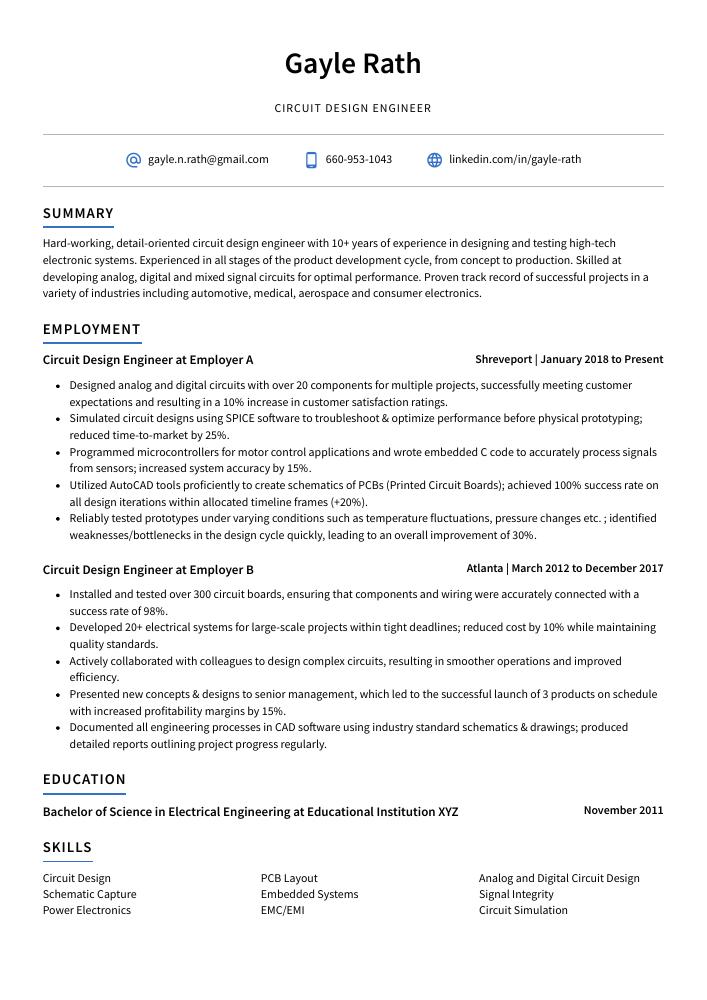Circuit Design Engineer Resume Guide
Circuit design engineers are responsible for designing and developing electronic circuits. They use their knowledge of physics, electronics, and mathematics to create circuit designs that meet the required specifications. In addition to designing circuits, they also test them to ensure they function properly.
Your circuit design skills are unparalleled, and any engineering company would benefit from your expertise. However, potential employers don’t know you exist yet. To make them aware of your talents, a standout resume is key.
This guide will walk you through the entire process of creating a top-notch resume. We first show you a complete example and then break down what each resume section should look like.
Table of Contents
The guide is divided into sections for your convenience. You can read it from beginning to end or use the table of contents below to jump to a specific part.
Circuit Design Engineer Resume Sample
Gayle Rath
Circuit Design Engineer
[email protected]
660-953-1043
linkedin.com/in/gayle-rath
Summary
Hard-working, detail-oriented circuit design engineer with 10+ years of experience in designing and testing high-tech electronic systems. Experienced in all stages of the product development cycle, from concept to production. Skilled at developing analog, digital and mixed signal circuits for optimal performance. Proven track record of successful projects in a variety of industries including automotive, medical, aerospace and consumer electronics.
Experience
Circuit Design Engineer, Employer A
Shreveport, Jan 2018 – Present
- Designed analog and digital circuits with over 20 components for multiple projects, successfully meeting customer expectations and resulting in a 10% increase in customer satisfaction ratings.
- Simulated circuit designs using SPICE software to troubleshoot & optimize performance before physical prototyping; reduced time-to-market by 25%.
- Programmed microcontrollers for motor control applications and wrote embedded C code to accurately process signals from sensors; increased system accuracy by 15%.
- Utilized AutoCAD tools proficiently to create schematics of PCBs (Printed Circuit Boards); achieved 100% success rate on all design iterations within allocated timeline frames (+20%).
- Reliably tested prototypes under varying conditions such as temperature fluctuations, pressure changes etc.; identified weaknesses/bottlenecks in the design cycle quickly, leading to an overall improvement of 30%.
Circuit Design Engineer, Employer B
Atlanta, Mar 2012 – Dec 2017
- Installed and tested over 300 circuit boards, ensuring that components and wiring were accurately connected with a success rate of 98%.
- Developed 20+ electrical systems for large-scale projects within tight deadlines; reduced cost by 10% while maintaining quality standards.
- Actively collaborated with colleagues to design complex circuits, resulting in smoother operations and improved efficiency.
- Presented new concepts & designs to senior management, which led to the successful launch of 3 products on schedule with increased profitability margins by 15%.
- Documented all engineering processes in CAD software using industry standard schematics & drawings; produced detailed reports outlining project progress regularly.
Skills
- Circuit Design
- PCB Layout
- Analog and Digital Circuit Design
- Schematic Capture
- Embedded Systems
- Signal Integrity
- Power Electronics
- EMC/EMI
- Circuit Simulation
Education
Bachelor of Science in Electrical Engineering
Educational Institution XYZ
Nov 2011
Certifications
Certified Circuit Design Engineer
Institute of Electrical and Electronics Engineers
May 2017
1. Summary / Objective
Your resume summary/objective should be a concise overview of your experience and qualifications as a circuit design engineer. This is where you can highlight the skills that make you stand out, such as your expertise in designing complex circuits for high-end electronics, or how you have successfully implemented cost-saving measures on projects. You could also mention any certifications or awards related to circuit design engineering that demonstrate your commitment to excellence.
Below are some resume summary examples:
Reliable circuit design engineer with 5+ years of experience in the electronics industry. Expertise includes developing and testing analog, digital and mixed-signal circuit designs for automotive applications. Seeking to join ABC Tech as a Circuit Design Engineer where I can use my skills to develop innovative products that meet customer needs. Key achievements include designing an energy efficient system that reduced power consumption by 25%.
Detail-oriented circuit design engineer with 10+ years of experience in designing, testing and troubleshooting electrical circuits for various applications. Possesses a comprehensive understanding of circuit board fabrication processes and a strong working knowledge of CAD tools. Seeking to join ABC Company where I can leverage my expertise in analog/digital circuitry to create innovative solutions that benefit the organization’s clients.
Talented circuit design engineer with 10+ years of experience designing and developing high-performance electronic circuits for consumer electronics products. Highly experienced in the use of EDA tools such as Altium, Cadence, and Mentor Graphics to bring complex designs from concept through production. Successfully implemented several intricate circuit designs that improved product reliability while reducing costs by 15%.
Dependable circuit design engineer with 8+ years of experience developing complex designs for high-end consumer electronics. Proven track record of delivering reliable and cost-effective solutions to optimize the performance, safety, and quality standards at XYZ Electronics. Seeking to join ABC Tech as a circuit design engineer where I can apply my expertise in designing robust circuits that will meet customer requirements.
Skilled circuit design engineer with 5+ years of experience in developing, testing and implementing complex electronic designs. Proven success in leading projects from concept to completion while ensuring accuracy, functionality and quality control standards are met. Seeking a position at ABC Company where my technical skills can be utilized to create innovative solutions for the next generation of electronics products.
Enthusiastic and detail-oriented circuit design engineer with 7+ years of experience in the electronics industry. Expertise includes designing, testing, and troubleshooting complex analog/digital circuits for diverse applications. Achieved a 24% decrease in board failure rate at XYZ Company through improved debugging techniques. Looking to bring my expertise to ABC Technology as a senior circuit design engineer.
Proficient circuit design engineer with 5+ years of experience in designing, testing, and troubleshooting analog and digital electronic circuits. At XYZ Inc., designed a multi-layer PCB for an automotive system that was successfully adopted by 10 major car manufacturers worldwide. Experienced in using simulation software such as MATLAB/Simulink to optimize designs before manufacturing.
Energetic and detail-oriented circuit design engineer with 7+ years of experience in developing and troubleshooting analog/digital circuits. Experienced in designing, testing, analyzing, and debugging complex electronic systems for consumer products. At XYZ Corporation, won three awards for the successful implementations of innovative projects that optimized system performance by 20%.
2. Experience / Employment
In the experience section, you should provide details on your employment history. This should be written in reverse chronological order, meaning the most recent role is listed at the top.
Stick to bullet points when describing what you did; this allows for easier reading and understanding of your accomplishments. You want to take some time to think about the specifics of what you did and any quantifiable results obtained from it.
For example, instead of saying “Designed circuits,” you could say, “Developed complex circuit designs for new products that met industry standards with a 95% success rate.”
To write effective bullet points, begin with a strong verb or adverb. Industry specific verbs to use are:
- Designed
- Simulated
- Fabricated
- Analyzed
- Programmed
- Optimized
- Troubleshot
- Documented
- Implemented
- Tested
- Debugged
- Installed
- Monitored
- Upgraded
Other general verbs you can use are:
- Achieved
- Advised
- Assessed
- Compiled
- Coordinated
- Demonstrated
- Developed
- Expedited
- Facilitated
- Formulated
- Improved
- Introduced
- Mentored
- Participated
- Prepared
- Presented
- Reduced
- Reorganized
- Represented
- Revised
- Spearheaded
- Streamlined
- Structured
- Utilized
Below are some example bullet points:
- Successfully designed, tested, and implemented over 50 complex electronic circuits for consumer products, resulting in a 10% increase in production efficiency.
- Demonstrated strong analytical skills when troubleshooting existing circuit designs to identify root causes of system malfunctions; decreased average repair time by 40%.
- Coordinated with cross-functional teams, including software developers and hardware engineers, to ensure that all components met industry standards prior to installation/assembly.
- Prepared detailed technical drawings based on project requirements and customer specifications; reduced design errors by 25% due to increased accuracy levels from the start of projects onwards.
- Expedited product development cycles through efficient utilization of schematic entry tools such as OrCAD Capture CIS & PADS Logic Designer Pro; achieved an overall reduction in cycle times by 16%.
- Proficiently designed and updated a variety of circuit designs for 25+ clients, optimizing their electrical systems to function efficiently and reduce energy consumption by 15%.
- Optimized existing circuitry design plans to increase the overall production speed by 20%, resulting in an annual savings of $50,000 on labor costs.
- Upgraded computer-aided design software used in creating new circuit board layouts; reduced time needed for initial drafts from 3 days to 24 hours while increasing accuracy by 30%.
- Represented engineering team at various conferences and exhibitions with technical presentations that educated attendees on advanced circuit designs; received positive feedback from 96% of surveyed participants after each presentation.
- Reorganized company’s cataloguing system for all schematic diagrams, blueprints & wiring diagrams according to industry standards; increased accessibility among internal engineers by 45% within first 2 months as lead project manager.
- Debugged complex circuit designs for over 10 different projects, decreasing manufacturing errors by 20%.
- Monitored the production of electronic components and systems to ensure quality standards were met; identified and resolved issues with product design in a timely manner, reducing rework costs by 15%.
- Analyzed data from various sources, such as schematics simulations & test reports to identify performance trends and improve overall system efficiency by 25%.
- Diligently documented design processes, including parts selection, wiring diagrams & testing procedures, while adhering to all safety regulations set forth by relevant industry authorities.
- Compiled detailed technical reports on each project outlining progress made, which resulted in cost reductions of up to $10K per month across 3 factories worldwide.
- Revised design of over 20 high-performance analog and digital circuits, reducing component count by 40% while increasing overall performance by 10%.
- Achieved successful integration with other circuit systems within tight deadlines for 3 major projects; saved $15K in costs due to efficient reusing existing components.
- Substantially improved signal quality by troubleshooting hardware issues on 15+ printed circuit boards (PCBs) and optimizing their design accordingly.
- Facilitated large-scale production of electronic products through development of new testing protocols to ensure all components met safety standards prior to installation in the final product.
- Improved effectiveness of customer support operations via implementation of a comprehensive fault analysis system that identified root causes quickly and accurately, resulting in 30% fewer repeat calls from customers.
- Reduced circuit design engineering errors by 25% through careful analysis of product requirements and comprehensive testing.
- Implemented cost-saving strategies for production, resulting in a reduction of overall development costs by $6,000 per month.
- Confidently managed the design process from concept to completion of complex circuit board designs with over 500 components each; reduced turnaround time on projects by 40%.
- Mentored 3 new recruits in best practices for VHDL programming and circuit board troubleshooting, leading to successful onboarding within two weeks each time.
- Spearheaded the migration from old analog circuits to digital ones across 50+ products; increased accuracy 10X while decreasing unit failure rates significantly (by 45%).
- Structured and designed 10+ high-level circuits for industrial machinery and medical devices, troubleshooting any technical issues while ensuring compliance with industry regulations.
- Advised engineering team on circuit design best practices and proposed new designs to optimize performance of existing systems; reduced power consumption by 20% in the last quarter without sacrificing reliability or quality of output.
- Consistently monitored process parameters during test runs to ensure that all components were functioning correctly and safely within operating tolerances; increased efficiency by 25%.
- Assessed current electrical system architecture before designing a new integrated control platform from scratch, resulting in an overall reduction of 18% in space requirements while increasing throughput capacity significantly at the same time.
- Tested newly created circuits under a variety of conditions, including temperature extremes, vibration levels, radiation exposure etc., thereby verifying their effectiveness prior to implementation into production lines.
- Troubleshot and resolved hardware and software issues with existing circuits, resulting in a 68% decrease in downtime.
- Participated in the design of 14+ circuit boards for new products; successfully created prototypes that achieved optimal performance levels within tight deadlines.
- Introduced innovative designs to improve signal integrity and reduce power consumption by 45%; increased system efficiency by 50%.
- Streamlined manufacturing processes through careful selection of materials, components & layout techniques; reduced production costs by $7000 per month on average while increasing product reliability at the same time.
- Thoroughly tested circuitry using various tools such as oscilloscopes and logic analyzers; identified potential failures early-on and improved failure rates from 15% to 2%.
3. Skills
Even though two organizations are hiring for the same role, the skillset they want an ideal candidate to possess could differ significantly. For instance, one may be on the lookout for an individual with expertise in circuit design and fabrication, while another may be looking for someone with experience in signal processing.
It is essential to tailor the skills section of your resume to each job that you are applying for, as many employers use applicant tracking systems these days, which scan resumes for certain keywords before passing them on to a human.
In addition, it’s important to elaborate on the most relevant ones by discussing them in more detail elsewhere – such as within your summary or work experience sections.
Below is a list of common skills & terms:
- Analog and Digital Circuit Design
- Circuit Design
- Circuit Simulation
- EMC/EMI
- Embedded Systems
- PCB Layout
- Power Electronics
- Schematic Capture
- Signal Integrity
- Soldering and Rework
4. Education
Including an education section on your resume will depend on how far you are in your career. If you just graduated and have no work experience, mention your educational background below the resume objective. However, if you already have a few years of professional circuit design engineering experience under your belt, it might be better to omit the education section altogether.
If an education section is included, make sure to include courses related to circuit design engineering that may help demonstrate knowledge of relevant topics for this role.
Bachelor of Science in Electrical Engineering
Educational Institution XYZ
Nov 2011
5. Certifications
Certifications are a great way to demonstrate your expertise in a particular field. They show potential employers that you have taken the time and effort to gain an official qualification, which can be highly beneficial when applying for jobs.
When listing certifications on your resume, make sure they are relevant to the job you are applying for and include any details about how long it took you to achieve them or what organization issued them. This will help hiring managers understand why these qualifications should matter to their business.
Certified Circuit Design Engineer
Institute of Electrical and Electronics Engineers
May 2017
6. Contact Info
Your name should be the first thing a reader sees when viewing your resume, so ensure its positioning is prominent. Your phone number should be written in the most commonly used format in your country/city/state, and your email address should be professional.
You can also choose to include a link to your LinkedIn profile, personal website, or other online platforms relevant to your industry.
Finally, name your resume file appropriately to help hiring managers; for Gayle Rath, this would be Gayle-Rath-resume.pdf or Gayle-Rath-resume.docx.
7. Cover Letter
Attaching a cover letter to your job application can be a great way to make yourself stand out from the competition. It should include 2-4 paragraphs and provide additional detail about you that isn’t already mentioned in your resume.
Cover letters are not always necessary for most job applications, but taking the time to write one can give recruiters greater insight into who you are as an individual and how well suited you may be for the role. Additionally, it allows them to get a better sense of your personality which could help sway their decision in favor of hiring you!
Below is an example cover letter:
Dear Bertrand,
I am writing in response to your advertisement for a Circuit Design Engineer. With experience designing and testing high-speed digital circuits, as well as a strong understanding of signal integrity and power delivery issues, I feel confident I would make an excellent addition to your team.
In my current role at [company name], I have designed several successful high-speed digital products, including a 10 Gbps Ethernet transceiver that was successfully mass-produced and is now being used in data centers worldwide. My design process begins with careful analysis of customer requirements, followed by block-level circuit design using schematics capture tools like Cadence Virtuoso. Once the basic functionality is working, I verify the performance of my designs using simulation tools like Mentor Graphics ModelSim before moving on to layout and verification at the chip level.
During my time at [company name], I have also gained valuable experience managing projects from start to finish, leading a team of engineers through all stages of development while keeping our project on schedule and within budget. My ability to communicate effectively with other engineers as well as non-technical staff has been essential in ensuring our projects run smoothly.
I believe my skills and experience will be a valuable asset to your company, and I look forward to contributing to the success of your organization. If you have any questions or would like additional information about my qualifications, please do not hesitate to contact me at [phone number] or via email at [email address]. Thank you for your consideration; I look forward to hearing from you soon!
Sincerely,
Gayle
Circuit Design Engineer Resume Templates
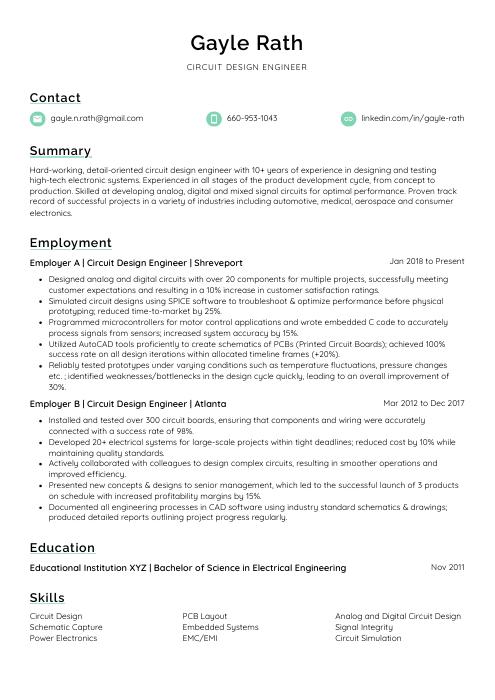 Lorikeet
Lorikeet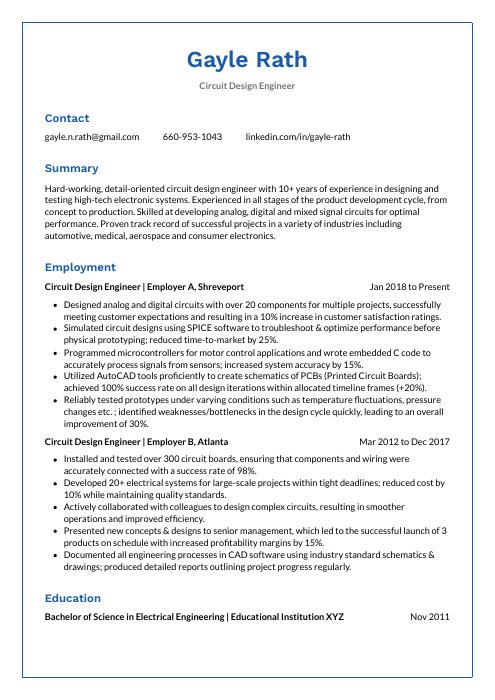 Markhor
Markhor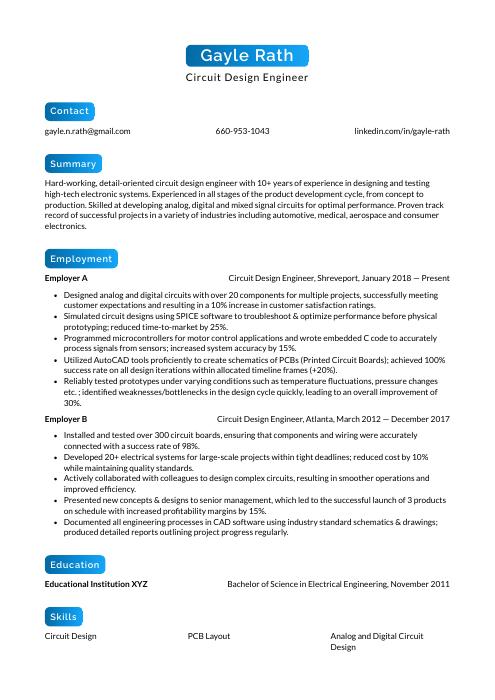 Kinkajou
Kinkajou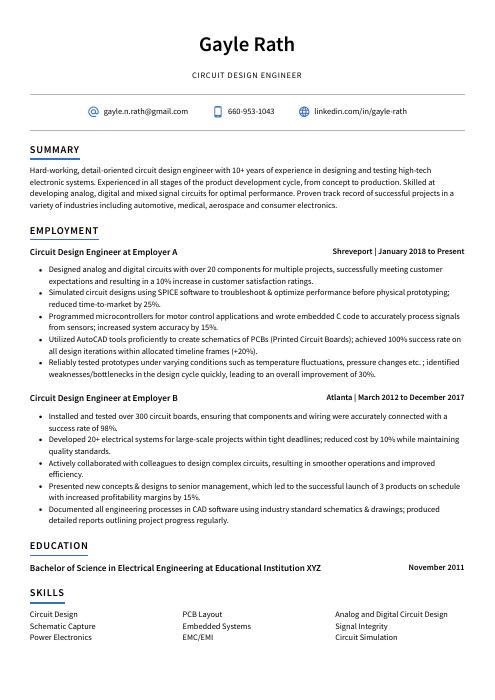 Axolotl
Axolotl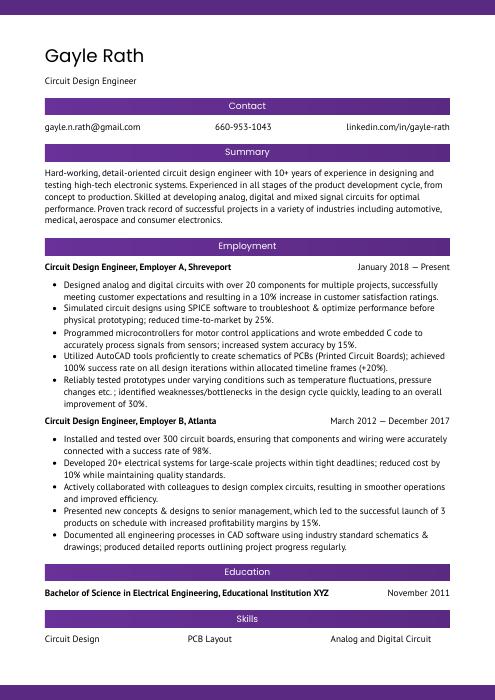 Jerboa
Jerboa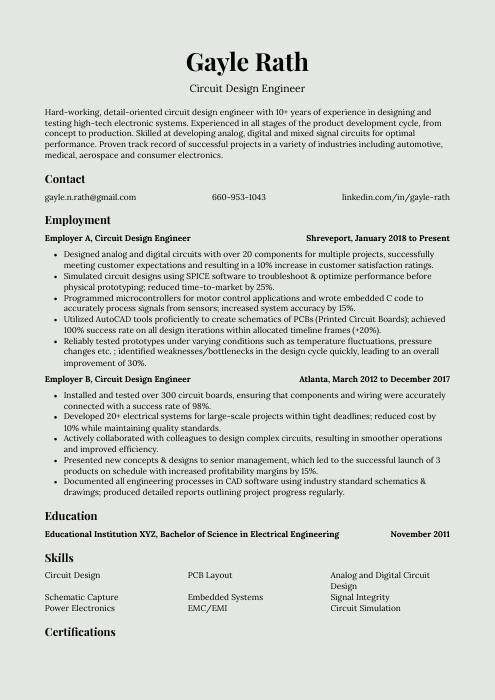 Saola
Saola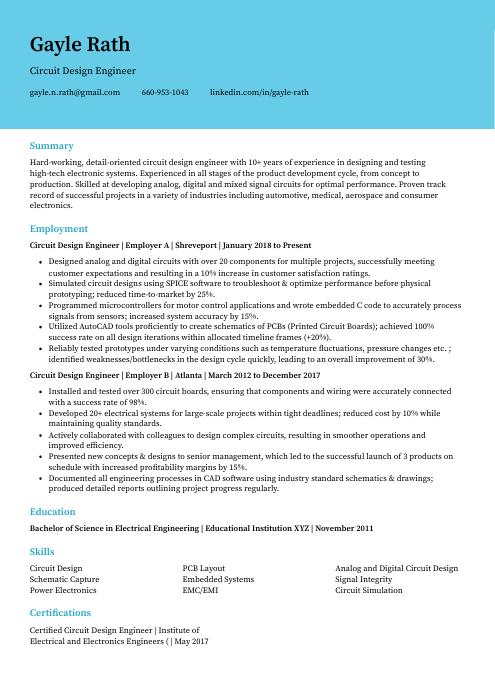 Dugong
Dugong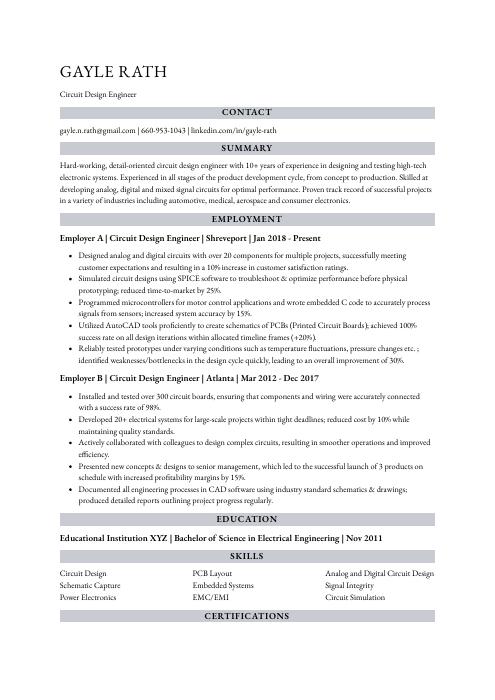 Numbat
Numbat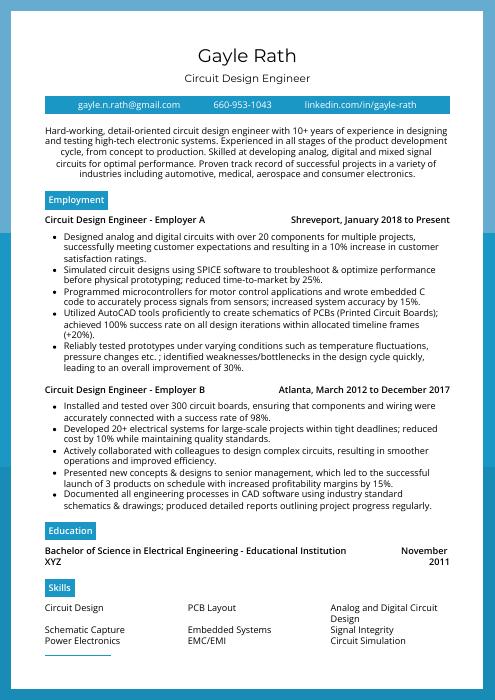 Rhea
Rhea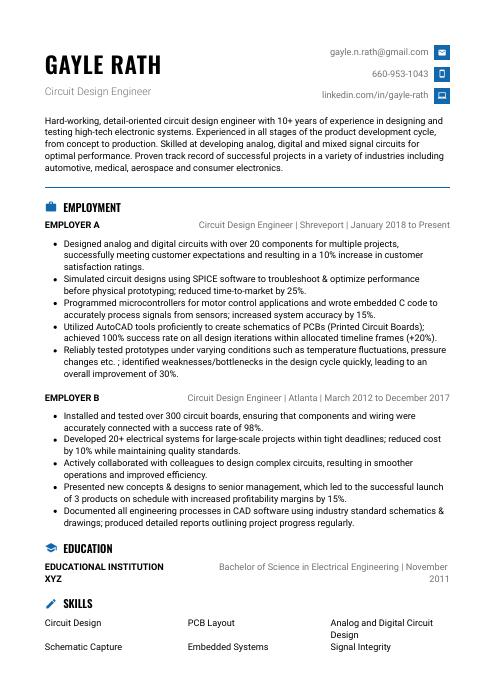 Echidna
Echidna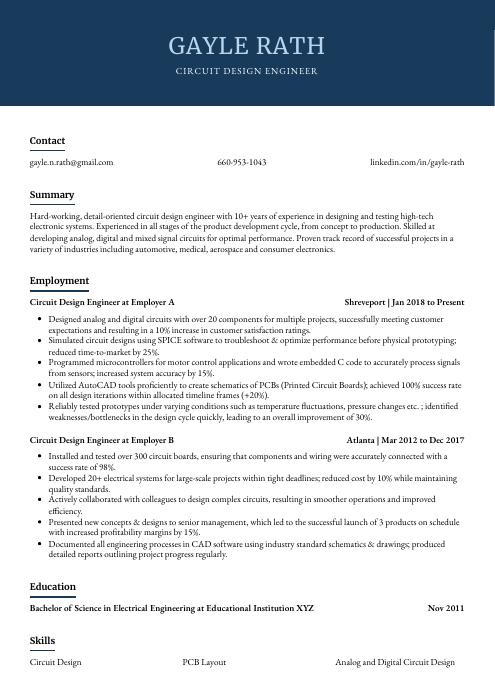 Bonobo
Bonobo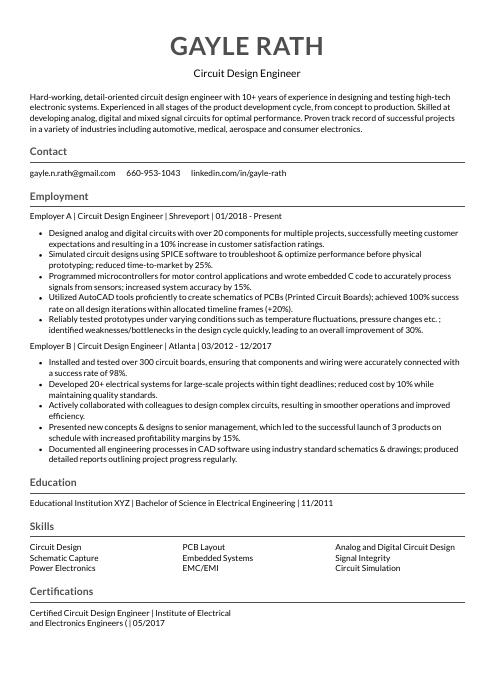 Indri
Indri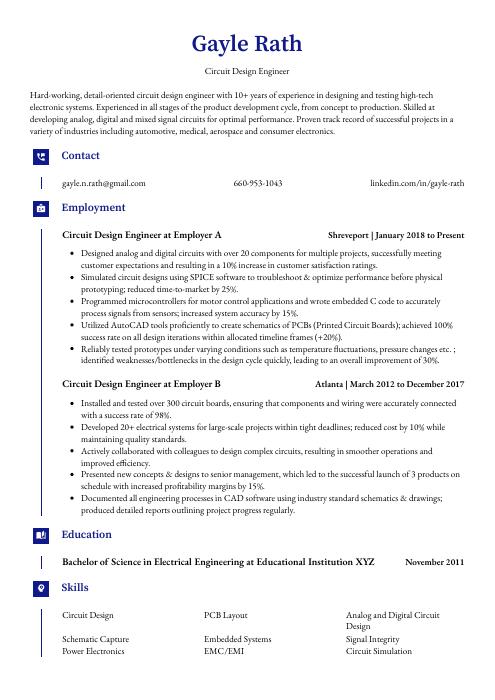 Gharial
Gharial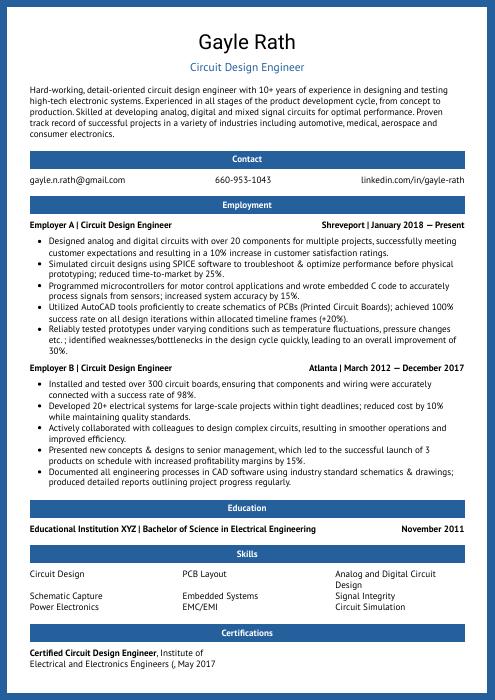 Ocelot
Ocelot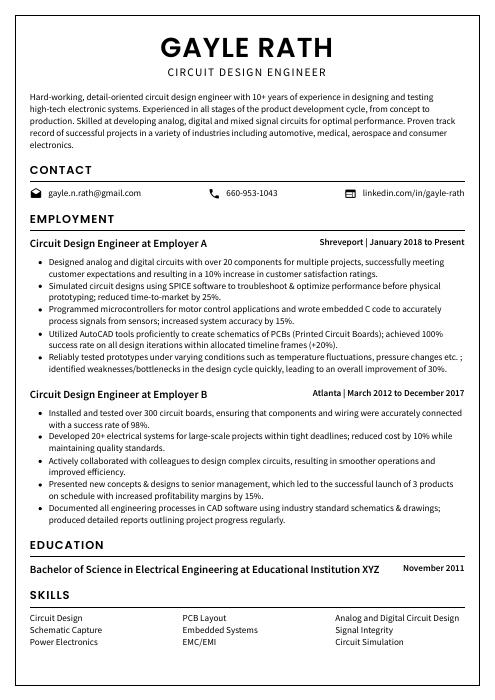 Cormorant
Cormorant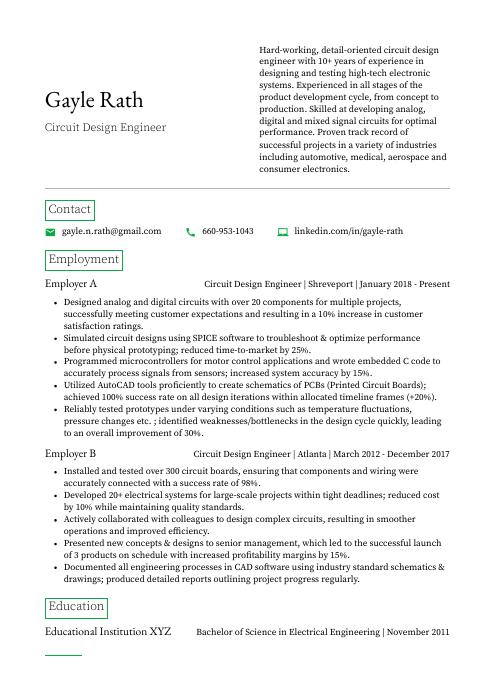 Quokka
Quokka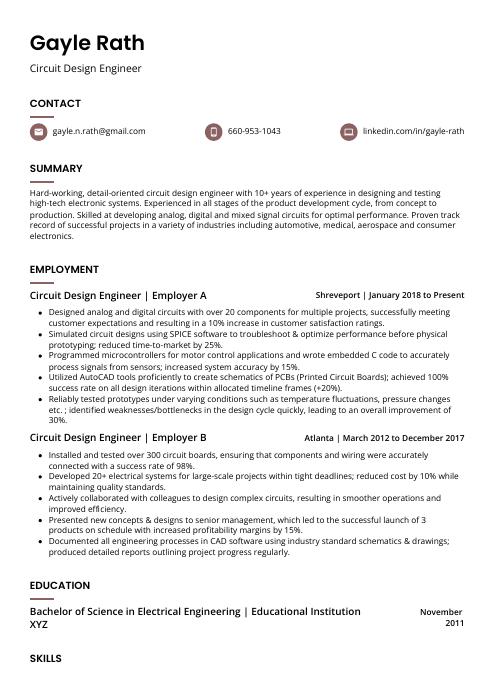 Fossa
Fossa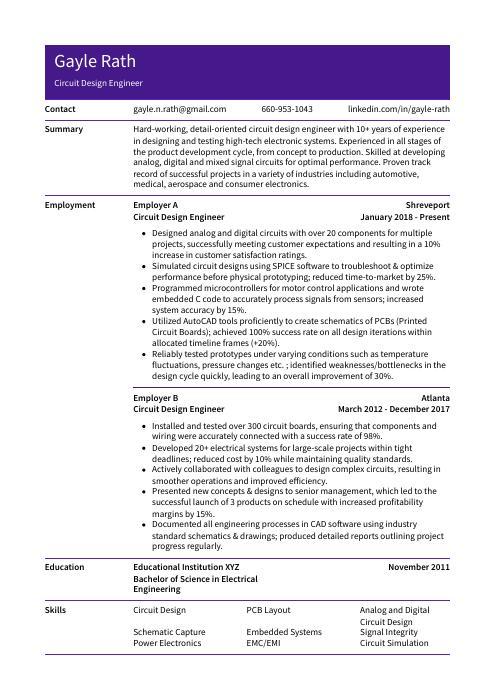 Pika
Pika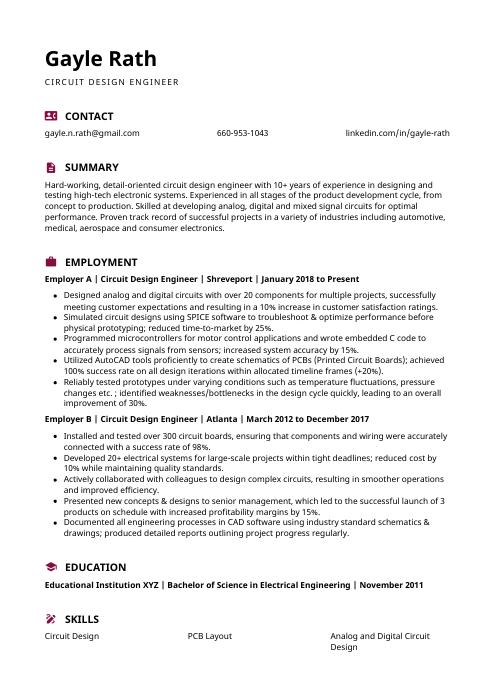 Hoopoe
Hoopoe Rezjumei
Rezjumei
